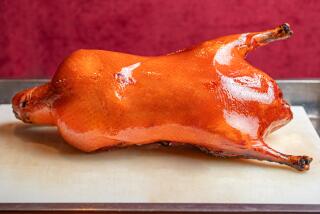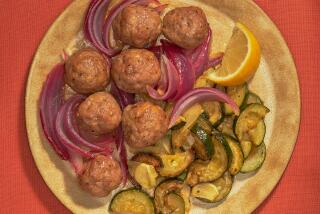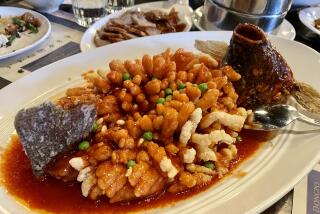A duck for all seasons
- Share via
As someone who cooks by the calendar, I’ve always wondered why strawberries and corn on the cob are socially acceptable any time of year, while duck is so often perceived as food for fall and winter. It’s a great ingredient naturally available in any month, and yet it’s trapped in a season warp.
Maybe when the only duck to be had was wild there was a reason to hold off on cooking it until hunting season. But ever since Pekin ducks were introduced into this country from China in 1873, domesticated birds have always been sold from July through June.
I’m prejudiced because I’m not a chicken-eater, but to me there’s no better poultry for summer meals. It’s more dramatic than turkey, more stylish than Cornish hens and more versatile than either. You can grill it, you can bake it, you can smoke it -- you could even eat it raw if you dared tartare. Even better, it goes with most everything in season right now: peaches and corn, basil and tomatoes, new potatoes and summer squash.
If one thing has kept this overlooked dark meat from becoming the bird in every pot, it’s the whole thing. Ducks have always been sold giblets and all, and slaving over a hot grill with an entire 5-pounder does not exactly inspire smiles on a summer night. Duck’s reputation for being half meat, half fat has also given it a “don’t touch, don’t cook” aura.
Once a duck has been cut down to size, though, it’s a different dinner. More and more, just the breasts or the legs are available in markets. Not only does that mean much of the fat is out of the picture, it also means duck has become tantalizingly easy to cook, and fast -- the breasts take less than 10 minutes.
Duck is much more interesting to play with than chicken; you can do things to it you wouldn’t try with a boneless, skinless breast. It also has a wow factor: Although you expect to find it in restaurants, duck is just not considered home cooking. And any dinner party guest presented with a crunchy roasted leg or juicy grilled breast is not going to go home bored to Perdue.
The leftovers are also more inspiring than turkey or chicken, or even beef or pork -- so much so that I sometimes cook extra just so we can have duck burritos or curry or salad the next day, and the day after. A duck quesadilla with mango, jalapenos and Brie is a many-splendored incentive for overbuying.
More and more, duck is sold in forms even those longtime masters the Chinese and the French never dreamed of. In some markets, and always online (at sites such as www.dartagnan.com), you can buy duck confit, smoked duck, duck sausage, duck prosciutto and even duck bacon.
Confit is actually what has started to move duck out of fall and winter exile and onto menus year-round. Just about any restaurant worth its Breton sea salt serves the whole leg now on a bed of greens, or with roasted potatoes. Now home cooks can buy confit just as chefs do, and what originated as a way of preserving meat through the winter makes a summertime duck lunch not only possible, but even enticing.
Once all those legs were being carved off for confit, duck producers had breasts to spare. Magret, the big, gamy filet from the moulard ducks raised for foie gras as well as confit, lately is in high-end stores everywhere. But even mainstream producers such as Maple Leaf Farms are making confit and selling breasts.
Some duck dealers also sell Muscovy breasts and legs, but to me the best variety is good old Pekin, also known as Long Island duck (even though most of the birds are now raised far from New York state, mostly in Indiana). More refined palates may prefer the more nuanced texture and slightly gamier flavor of Muscovy and moulard. But even though Pekin is milder, no one would ever say it tastes like chicken.
According to the Duckling Council (naturally, this bird has a trade group), American consumption of duck is rising in general but sales of parts alone are the real growth industry: They’re up from 5% in 1993 to 30% to 40% today.
And those parts are not just parts. The breasts and the legs have a dusky flavor even though they are actually lean -- the flesh is not marbled (all the fat is in or under the skin). Even that melts away before you slice into a piece.
As fast as the breasts cook, they are actually trickier to handle than the legs. Overcooking will give you a lovely sandal, while undercooking will leave you with tough-to-cut fatty skin. Sauteing or broiling renders the fat and crisps the skin perfectly. But if you want to grill, I’ve learned it’s best to score the skin in a fine crosshatch pattern, then marinate it in soy sauce for flavor and appetizing color before tossing the breasts onto the fire.
In about eight minutes, the meat will still be bright-red rare. Letting it rest on a rimmed cutting board for about five minutes before you slice it leaves it just right -- a beautiful medium-rare.
With the legs, the secret is low and slow. You want the meat to soften as the fat cooks away, leaving the skin crisp. My standard tenderizing procedure for summer is borrowed from Madeleine Kamman, who in “In Madeleine’s Kitchen” suggests roasting the legs under a coating of Dijon mustard and breadcrumbs. The crust keeps in the juices while the meat turns succulent.
I added a sprinkling of herbes de Provence because they’re so complementary to the meat, and substituted Japanese panko for my usual Progresso crumbs, and came up with something that never fails to dazzle dinner guests. The meat gets almost confit-tender while the skin is as crusty as fried chicken (or, as my consort says, as Shake ‘n Bake).
The legs can just be seasoned and stuck in an oven at 325 degrees for an hour and a half, with no fussiness. But a trick I borrowed from “Bay Wolf Cookbook” (from the Oakland restaurant of the same name) makes a huge difference: After the legs have cooked dry for an hour, I pour something liquid around them and let them cook another half an hour. The meat gets super-tender while the skin crisps from the combination roasting and braising.
I’ve tried everything from the Pinot Noir in the cookbook to vermouth to a tomatillo salsa with pumpkin seeds and gotten great results for serving plain. But when I want to make meat for tacos, I use beer spiked with chopped chipotle peppers; the cooking liquid can then be used to moisten the meat after it’s shredded and before it’s folded into fresh corn tortillas with salsa and queso fresco, plus radishes and scallions for flavor and crunch.
Duck legs roasted and braised with wine are almost as good as confit, and they can be served the same way: on mesclun or in a creamy potato salad sharpened with capers, cornichons and a bed of frisee.
To me, duck responds best to savory flavors; I’ve never understood why it has to be turned into meat candy with orange sauce or raspberry jam. But summer fruit with a savory side is different. Peach chutney spiced with lots of fresh ginger makes an irresistibly pungent partner for grilled duck.
If duck in summer still seems odd, just consider that cooks in some of the world’s hottest places have always relied on it in the hottest months. And they make it as hot as they can stand. In New Orleans, duck is a staple in spicy gumbo, jambalaya and etouffee, for instance, while in Thailand it’s eaten in incendiary curries with green or red sauces. Hot food does cool you off. And duck stands up to the heat better than strawberries do to the cold.
*
Duck legs roasted with mustard
Total time: 1 1/2 to 2 hours
Servings: 2 to 4
Note: This recipe is adapted from one in Madeleine Kamman’s “In Madeleine’s Kitchen” (Collier Books, 1984).
4 duck legs (thighs included, about 2 1/2 pounds)
2 teaspoons herbes de Provence, crumbled
Sea salt and freshly ground black pepper
4 tablespoons Dijon mustard
1/3 cup panko or other dry breadcrumbs
2 tablespoons melted butter
6 cups mesclun or other greens
1. Heat the oven to 325 degrees.
2. Rinse the duck legs and pat them dry. Rub them all over with the herbes de Provence. Season well with salt and pepper. Spread the mustard over the skin side of each leg to coat thinly. Lay the legs in a shallow baking dish, leaving space between them. Sprinkle evenly with the panko or breadcrumbs and drizzle evenly with the melted butter.
3. Roast 1 1/2 to 2 hours, or until the meat is very tender and the coating is crisp. Serve on a bed of mesclun (no dressing is necessary as the duck juices and mustard will coat the salad).
Each of four servings: 421 calories; 41 grams protein; 10 grams carbohydrates; 2 grams fiber; 24 grams fat; 8 grams saturated fat; 177 mg. cholesterol; 557 mg. sodium.
*
Duck and potato salad
Total time: 2 hours
Servings: 4 as an appetizer or lunch entree
4 duck legs (thighs included, about 2 1/2 pounds)
Sea salt and freshly ground black pepper
1/2 teaspoon oil
1 teaspoon dried thyme
4 large garlic cloves, peeled
1 cup dry white wine or vermouth
1 pound fingerling (or baby Yukon Gold) potatoes, scrubbed
2 tablespoons mayonnaise
1 tablespoon Dijon mustard
2 tablespoons white wine vinegar
2 shallots, peeled and minced
6 cornichons, finely diced
1 tablespoon drained capers
2 tablespoons chopped chives, plus extra for garnish
1 tablespoon chopped fresh dill
1 tablespoon chopped fresh basil
1 large bunch frisee, torn into pieces, or 8 romaine leaves, or 4 cups arugula
1. Heat the oven to 325 degrees. Rinse the duck legs and pat them dry. Season them well on both sides with the salt and pepper and lay them in an oiled, shallow baking dish. Sprinkle with thyme and arrange the garlic cloves around. Roast 1 hour. Opening the oven briefly, pour the wine or vermouth carefully around the legs, avoiding the skin. Continue roasting until the meat is very tender, about 30 minutes longer. Set aside to cool slightly.
2. While the duck cooks, place the potatoes in a large pot of salted water and bring to a rolling boil. Reduce the heat and simmer until just tender, about 25 minutes. Drain well.
3. While the potatoes cook, whisk together the mayonnaise, mustard, vinegar, shallots, cornichons, capers, chives, dill and basil. Season with salt and pepper to taste.
4. Thinly slice the still-warm potatoes on the diagonal and place in a large bowl. Pour the dressing over them and toss to coat. Shred the duck meat with two forks into large chunks and add to the bowl (discard the skin if it’s too tough). Toss again. Taste and adjust the seasoning. Arrange on the frisee, romaine leaves or arugula; sprinkle with a good handful of the chopped chives and serve warm.
Each serving: 566 calories; 44 grams protein; 36 grams carbohydrates; 10 grams fiber; 23 grams fat; 5 grams saturated fat; 166 mg. cholesterol; 642 mg. sodium.
*
Grilled duck breasts with fresh ginger-peach chutney
Total time: 45 minutes
Servings: 4
2 medium peaches
1/4 cup apple cider vinegar
1 tablespoon fresh lime juice
1 tablespoon minced fresh ginger
2 fresh jalapeno chiles, seeded and minced
2 tablespoons minced shallots
1/2 teaspoon ground allspice
1/2 teaspoon ground cloves
1 (1/2-inch) piece of cinnamon stick
1/4 cup raisins
1/3 cup sugar
Salt
8 (8-ounce) duck breast filets (half-breasts)
1 cup soy sauce
Freshly ground black pepper
1. Bring a pot of water to a rolling boil. Add the peaches and blanch 30 seconds. Cool slightly, then slide or pare the skins off. Cut the flesh into half-inch pieces and place in a clean, nonreactive saucepan.
2. Add the vinegar, lime juice, ginger, jalapenos, shallots, allspice, cloves, cinnamon stick and raisins, and mix well. Stir in the sugar. Bring to a boil, then reduce the heat and simmer, uncovered, 30 minutes or until thickened, stirring occasionally. Season with salt to taste and set aside.
3. Rinse the duck breasts and pat them dry. Using a sharp knife, carve off any excess fat and skin, then score the skin in a fine crosshatch pattern, without cutting into the flesh. Lay skin-side-down in the soy sauce in a shallow dish and marinate 30 minutes.
4. Heat a grill until very hot. Season the breasts with salt and pepper and lay skin-side-down on the grill. Cook 3 minutes, then turn slightly to leave a crosshatch grill mark on the skin. Cook 1 minute, then flip over and cook until done to taste, about 3 to 4 minutes longer for medium-rare. Transfer the breasts to a cutting board with a rim to rest for 5 minutes longer.
5. Serve the breasts whole or sliced, with warm chutney on the side (reserve the remainder for another use).
Each serving: 824 calories; 86 grams protein; 33 grams carbohydrates; 2 grams fiber; 37 grams fat; 10 grams saturated fat; 463 mg. cholesterol; 1,297 mg. sodium.
*
Duck tacos
Total time: 2 hours
Servings: 4 to 6
4 duck legs
1 teaspoon ground cumin
1 teaspoon Mexican oregano
Salt and freshly ground black pepper
1/2teaspoon oil
3-4 chipotle peppers, packed in adobo sauce, finely chopped, divided
1 1/2 cups dark beer, room temperature
2 large ripe tomatoes, finely diced (about 2 cups)
1/4cup coarsely chopped fresh cilantro
5 radishes, washed, trimmed and cut into julienne (about 3/4 cup)
1/3cup finely chopped green onions, green part only
12 fresh corn tortillas
2 cups grated queso fresco or Monterey Jack cheese
2 limes, quartered
1. Heat the oven to 325 degrees. Rinse the duck legs and pat them dry. Combine the cumin and the oregano and rub the mixture all over the legs. Season with salt and pepper to taste. Brush a shallow (13-by-9-inch) baking dish with the oil and arrange the legs in it in a single layer. Roast 1 hour.
2. Combine 2 chipotles and the beer and carefully pour over and around the legs. Roast 30 minutes longer, until the meat is very tender. Set aside until cool enough to handle, then shred the meat and skin with two forks (discard any skin that is too tough). Pour 1 or 2 tablespoons of the pan juices over the meat, just enough to moisten, and toss to mix. Keep warm.
3. Combine the tomatoes, cilantro and remaining chipotles (to taste) in a small bowl. Season with salt and pepper to taste. Combine the radishes and green onions in another bowl and set aside.
4. Heat the tortillas one at a time in a nonstick skillet or on a griddle until warm and pliable. Lay them out on a serving plate and top one side of each with a little cheese, then a little duck, then a little salsa and finally with the radish-scallion mixture. Fold over and serve at once, with the limes to squeeze over the filling.
Each of four servings: 627 calories; 44 grams protein; 44 grams carbohydrates; 6 grams fiber; 31 grams fat; 14 grams saturated fat; 155 mg. cholesterol; 614 mg. sodium.
More to Read
Eat your way across L.A.
Get our weekly Tasting Notes newsletter for reviews, news and more.
You may occasionally receive promotional content from the Los Angeles Times.









